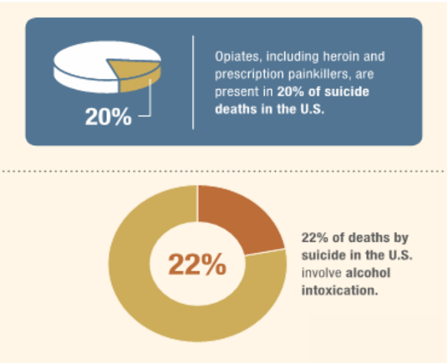How Much is Substance Abuse Involved in Reducing American Life Expectancy?

Multiple agencies and researchers have released reports in the last few years that indicate worsening mortality rates in America. Rather than our average life expectancy extending as science comes up with new answers, it’s been shortening. A new report indicates more deaths are happening among younger groups of Americans, individuals we would expect to live decades longer than they do.
This increase in mortality is not a simple problem with a single cause. But the influences of excessive alcohol use and drug use can be found as significant factors in this decline. First, let’s look at how our life expectancy has declined, especially among Americans who die prematurely. Then we’ll look at the ways alcohol and drug abuse might be increasing our loss of these young lives.
Life Expectancy History
Between 1959 and 2016, average American life expectancy increased almost ten years to 78.9 years. Then it declined for the next three years.
Changes in mortality patterns could be detected as far back as the 1990s. At that time, there began to be an increasing loss among younger Americans aged 25 to 64. Dying in this age range is referred to as a “midlife” death, and its increase was unexpected.
Based on an analysis published in the Journal of the American Medical Association Network (JAMA), the most significant midlife death increases are in two areas:
- New England (New Hampshire, 23.3%; Maine, 20.7%; Vermont, 19.9%)
- Ohio Valley (West Virginia, 23.0%; Ohio, 21.6%; Indiana, 14.8%; Kentucky, 14.7%)
Both of these regions have been devastated by opioid addiction and overdoses. According to the Centers for Disease Control and Prevention, several of these states are at the top of the list for high mortality resulting from drug overdoses.
Here are the states with the highest rates of overdose death per 100,000 population (bold type indicates states that also appear in the list above).
- West Virginia 57.8 deaths per 100,000 population
- Ohio 46.3
- Pennsylvania 44.3
- Kentucky 37.2
- New Hampshire 37
- Delaware 37
- Maryland 36.3
- Maine 34.4
You can see how several of the high overdose death rate states coincide with the list of states with the highest increases in midlife losses. Indiana is a few notches lower at 29.4 deaths per 100,000 population, and Vermont is several notches below that at 23.2.
The JAMA report estimates that, between 2010 and 2017, America experienced 33,000 “excessive” deaths among those in the middle of their lives.
What Typically Caused these “Excessive” Deaths?
Overdose deaths: Between 1999 and 2017, the number of people losing their lives to drug overdoses increased 387%, a truly staggering increase. For those aged 25 to 34, the growth was even more astonishing: 531%. The increase means that instead of losing 5.6 people per 100,000 population, we lost 35 people in the primes of their lives in 2017.
Alcohol-related liver disease: We also began to lose more people to chronic liver disease and cirrhosis. Between 1999 and 2017, our losses due to alcohol-related liver problems increased 41% among young adults.
Suicide: Among 25 to 64-year-olds, suicide increased 38.3% over the same period, and 56% among those aged 55 to 64. As noted by the Substance Abuse and Mental Health Administration, there is a close relationship between substance abuse and suicide.
- Opioids such as heroin or prescription painkillers are present in 20% of all suicide deaths.
- 22% of all suicide deaths involve alcohol.

Other causes: Other drug misuses or alcohol-related conditions that may have helped reduce longevity include lung disease, hypertension, stroke, and diabetes. While there are many factors involved in causing these illnesses, drug use or excessive alcohol use can be involved in causing all of them.
Other increasing causes of death included liver cancer, mental disorders, and injuries such as those resulting from pedestrian-vehicle collisions. All of these causes of death can be the result of drug or excessive alcohol use.
And as noted by the National Institute on Alcohol Abuse and Alcoholism: “[A]lcoholism can complicate or mimic practically any psychiatric syndrome seen in the mental health setting.”
The Governors Highway Safety Administration also reports:
- Pedestrian fatalities increased 27% from 2007-2016
- States that legalized recreational marijuana between 2012 and 2016 had a collective 16.4% increase in pedestrian fatalities in the first six months of 2017 compared to the prior year
- All other states experienced a 5.8% decrease.
Let’s Step Back a Moment

Yes, mortality and life expectancies are complicated situations. Indeed, there are many factors involved in changing the average American life expectancy. But I think that some conclusions are possible.
- Drug use, especially the use of powerfully addictive drugs like cocaine, crack cocaine, methamphetamine, and opioids, takes far too many lives.
- Alcohol also causes too many deaths, either directly by causing acute alcohol intoxication deaths or by triggering accidents in traffic or drownings, falls, homicides, or other causes of death.
- Alcohol causes death more slowly, too, through heart disease, cancer, diabetes, or other effects of excessive alcohol consumption.
- Even when a person does not die from these causes, drug use and alcohol overuse shatter families, devastate spouses, children and communities, and break hearts and minds.
The best and healthiest life—and the one likely to last the longest—is the one that’s free from alcohol and drugs. That’s the best path to a productive and enjoyable life for each of us.
Sources:
- https://jamanetwork.com/journals/jama/fullarticle/2756187
- https://www.cdc.gov/nchs/pressroom/sosmap/drug_poisoning_mortality/drug_poisoning.htm
- https://www.narconon.org/drug-abuse/effects-of-alcohol.html
- https://store.samhsa.gov/system/files/sma16-4935.pdf
- https://www.narconon.org/drug-abuse/alcohol/
- https://www.cancer.org/cancer/cancer-causes/diet-physical-activity/alcohol-use-and-cancer.html
- https://pubs.niaaa.nih.gov/publications/arh26-2/90-98.htm
- https://www.ghsa.org/resources/spotlight-pedestrians18


 ®
®